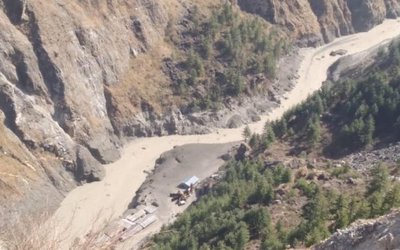Abstract
Climate change is one of the major issues in Environmental Law. Environmental Law and climate change law have a good relationship, as the actions taken to protect the environment will support in resolving climate change issues. Established principles of environmental law are also key to resolving the climate crisis. Environmental law must balance mitigating and minimizing emissions while protecting the environment to fulfill environmental objectives. However, in some instances, climate action has undermined environmental values and the enjoyment of human rights in several development-related projects. It shall be the responsibility of each state to prevent the foreseeable adverse impacts of climate change. Climate change is an environmental issue as it causes disproportionate harm to the environment and the overall economy of the country. Heavy floods, landslides, soil erosion, drought, and unwanted changes in temperature are some major impacts of climate change. It has multiple impacts on forests, water resources, agriculture, human health, and biodiversity. The Constitution of Nepal provides an obligation to the Nepalese government to protect the environment. According to the Treaty Act, 1990, Nepal has a clear obligation to abide by international instruments regulating and supporting climate change governance and policy implementation. In addition to recognition in international instruments, the Supreme Court of Nepal also concluded that climate change impaired the petitioner's constitutional right to a dignified life along with a clean and healthy environment. The court ordered the Government of Nepal to enact a new climate change law to mitigate and adapt to the effects of climate change, reduce the consumption of fossil fuels, and promote low-carbon technologies by developing scientific and legal instruments. The court also ordered the government to implement the existing national climate change policy until a new law is enacted. Despite this, there is still a need for a separate comprehensive Climate Act incorporating provisions under international instruments supporting developing nations and implementing policies properly.
Introduction:
The scenario of climate change and its adverse impact on the environment are heavily influenced by the existing national and international legal instruments combating such risks associated with the environment. We are quite aware of the contributions of both developed and developing countries in causing such actions. We are highly suffering from blame psychology rather than emphasizing common responsibilities. The question arises in our minds: why are these instruments not materialized and functional, whereas it is clear that poor implementation of state obligations on climate-related issues causes severe degradation of the environment and a high risk of climate change? It shall be the full responsibility of developed nations to cover the full incremental costs of mitigation and adaptation measures in developing countries to assist them, particularly those that are vulnerable to the adverse effects of climate change in meeting the cost of adaptation.
When the world is raising the issues of climate change and its consequences, South Asia has been facing the real problems of it through floods, droughts, cyclones, storms, air pollution, and many more. This is the reason why it has also been called one of the worst-affected regions by global warming and climate change.
Nepal ranks 4th and 30th in terms of climate change and flood risk, respectively. People's lives and livelihoods are at risk due to climate-induced multiple hazards, mainly floods, landslides, cold waves, heat stress, droughts, windstorms, lightning strikes, communicable diseases, and fires. The poor and marginalized, female-led households, and those in low-income informal settlements are among the most affected by the impacts of climate change.
Nepal, in particular, is ranked the fourth most vulnerable nation to climate change by a recent UN report, with the country feared to be on the receiving end of an environmental catastrophe. The early implications of disruption across the Himalayan ecosystem are already being felt. Changes in rainfall patterns are adversely affecting conditions that have sustained ecosystems for generations, as incessant and heavy rainfall results in reduced agricultural yield and pest proliferation. Moreover, changes in the glacial melt pattern are also expected to reduce the availability of freshwater, impact biodiversity, and diminish the production of hydroelectricity. It also increases the risk of erratic monsoons as floods and landslides become more frequent and either endanger or effectively displace entire communities.
Environmental issues are closely interlinked and interdependent with climate change issues. We know that multiple factors, including overexploitation of natural resources, population increase, and industrial activities, are major contributors to environmental degradation, which in turn impacts climate change. Climate change has emerged as an important aspect of environmental justice, as it is caused both naturally and by human activities that produce greenhouse gas emissions and involve the combustion of fossil fuels, altering the existing state of the environment. Environmental pollution is a key factor in causing changes in climate, impacting not only the environment but also human health.
The UN Human Development Report has indicated that mitigation efforts will begin to make a difference from the year 2030 onwards, and even in the best-case scenario, temperatures will continue to rise until around the year 2050.
The Constitution of Nepal
The Constitution of Nepal recognizes the right to a clean environment as a fundamental right. Article 30 of the Constitution of Nepal (2015) ensures the right to a clean environment, stating that every citizen has the right to live in a clean and healthy environment. Victims have the right to obtain compensation, in accordance with the law, for any injuries caused by environmental pollution or degradation.
Article 51 (g) outlines policies related to the protection, promotion, and use of natural resources, emphasizing sustainable use and biodiversity conservation. Additionally, in provisions related to agriculture, development, land reform, and agricultural security, environmental conservation is highlighted as a key element. The Constitution also includes provisions regarding the National Natural Resources and Fiscal Commission in Article 240, aiming for the sustainable and equitable distribution of natural resources among federal, provincial, and local levels.
The state shall direct its international relations towards enhancing the dignity of the nation in the world community by maintaining international relations on the basis of sovereign equality, while safeguarding the freedom, sovereignty, territorial integrity, independence, and national interest of Nepal.
Treaty Act, 1990 (2047 B.S)
Section 9 of the Act states that treaty provisions under international law are enforceable as national law. Article 9 (1) of the Treaty Act, 2047, states that international treaty provisions are enforceable as good as laws. It states that ‘any law of Nepal which contradicts with any treaty that is ratified by Nepal is null and void, to the extent it contradicts with such provisions. Moreover, it is stated in Article 9(2) that though a treaty which has not been ratified, acceded to, accepted, or approved by the Parliament, though to which Nepal or the Government of Nepal is a party, imposes any additional obligation to the Government of Nepal, and in case legal arrangements need to be made for its enforcement, the Government of Nepal shall initiate action as soon as possible to enact laws for its enforcement. Through the Treaty Act, Nepal is obliged to follow international law and customary international law in a binding manner.
Environment Protection Act, (EPA), 2019 (2076 B.S)
The Environment Protection Act is the umbrella legislation that deals with the conservation and protection of the environment. It consists of detailed provisions regarding the collection of information on the impacts of the ecological system and the formation of a separate council for the integration of environment and climate change. The act also includes detailed provisions regarding the reduction of carbon emissions and carbon trading.
The EPA of 2076 clearly states in its preamble that the main objective of the act is to protect the environment in order to safeguard the fundamental right of each citizen to live in a clean and healthy environment. It includes providing compensation to victims from polluters for causing any environmental harm or degradation to maintain a balance between the environment and development. Importantly, the preamble also addresses the impacts and challenges caused by climate change.
The act defines emission as the release of greenhouse gases or any other gas, smoke, or dust into the environment from a specific area within a certain period. It also defines adoption as the prevention or mitigation of further loss or damage by anticipating potential impacts and risks of climate change.
In section 2 (d) and (e), the act defines climate change and climate change management. Climate change is described as a gradual change in the Earth's climate directly or indirectly attributed to human activities that alter the composition of the global atmosphere and exhibit natural climate variability over comparable time periods. Climate change management refers to the mitigation or adaptation of problems arising from climate change, including policies, strategies, institutional mechanisms, provision of finance, and capacity building.
Chapters four, sections 23 to 28, discuss matters related to climate change and its impact on local communities, ecosystems, and biodiversity. Section 23 emphasizes public information and measures to mitigate adverse impacts on the environment. The Government of Nepal should adopt such measures when implementing projects at the federal, provincial, and local levels. Section 24 stresses the implementation of adaptation plans at all three levels of government, with a special focus on providing protection to communities vulnerable to the impacts of climate change.
The Government of Nepal identifies areas emitting greenhouse gases and determines their national reference level. The Ministry shall periodically monitor such levels, make updated information public, measure greenhouse gas emissions, and launch necessary programs for mitigation. The government of Nepal, by notification in the Nepal Gazette, provides necessary orders to adopt measures for mitigation in policies, strategies, and action plans. The act also includes the role of the private sector in such mitigation.
The Government of Nepal may also determine and enforce necessary standards for setting priorities for implementation in rural and urban areas to mitigate the adverse impacts and risks of climate change. The Government may prescribe necessary policy and technical standards required to mitigate such impacts. The Government of Nepal may also participate in carbon trading with mechanisms established by international treaties, foreign governments or organizations, business entities, or private entities for the mitigation and conservation of carbon emissions.
The National Climate Change Policy 2019 has been introduced with the objective of providing policy guidance to various levels and thematic areas towards developing a resilient society by reducing the risk of climate change impacts. The aims and purposes of this Policy are to contribute:
- to the socio-economic prosperity of the nation by building a climate-resilient society;
- to enhance the climate change adaptation capacity of persons, families, groups, and communities vulnerable to and at risk of climate change;
- to build resilience of ecosystems that are at risk of adverse impacts of climate change;
- to promote a green economy by adopting the concept of low carbon emission development;
- to mobilize national and international financial resources for climate change mitigation and adaptation in a just manner;
- to conduct research, develop effective technology, and deliver information services related to climate change;
- to mainstream or integrate climate change issues into policies, strategies, plans, and programs at all levels of the State and sectoral areas;
- to mainstream gender equality and social inclusion into climate change mitigation and adaptation programs.
UN Framework Convention on Climate Change (UNFCCC)
The UNFCCC was adopted on May 8, 1992, and Nepal became a party to this convention in 1994. Since then, it has come into force. The UNFCCC, adopted in 1992, describes climate change as a "common concern of mankind." Article 4 requires state parties to "promote and cooperate in the development, application, and diffusion" of emission-reducing technologies. The UNFCCC emphasizes ideas like "common but differentiated responsibilities."
As a specific multinational environmental agreement (MEA) on climate issues, it aims to stabilize greenhouse gas concentrations in the atmosphere at a level that would prevent dangerous anthropogenic interference with the climate system within a time frame sufficient to allow ecosystems to naturally adapt to climate change.
Article 3 and 4(3) of the convention impose a legal obligation for mitigation and adaptation measures based on the principle of ‘common but differentiated responsibilities and respective capabilities. It also includes developed countries' commitment to providing funds and financial resources required to meet the cost of mitigation and adaptation measures in developing countries. It also includes action related to the transfer of technology required for such actions. The Global Environmental Facility (GEF) has been designed as the institutional financial mechanism for the operation of funds and financial assistance, both grant and concession.
Kyoto Protocol, 1997
The Kyoto Protocol to the UN Framework Convention on Climate Change, adopted in December 1997, came into force on February 16, 2005. It reiterates that developed countries must provide new and additional financial resources to meet the agreed full cost and full incremental cost incurred by developing countries in advancing the implementation of existing commitments. Furthermore, developed countries are obligated to submit information regarding adaptation measures, programs, and finances in compliance with this protocol. They shall cooperate in the promotion of effective modalities for financial assistance and the transfer of technology. It aims at the full and effective implementation of the convention. It also emphasizes climate financing and reaffirms the legal obligations of developed nations. The Kyoto Protocol of 1997 maintained the UNFCCC's laissez-faire attitude toward imposing legally binding quantitative emission limits on Annex I nations. It also discusses the adoption of the Clean Development Mechanism (CDM) during certain renewable energy projects.
Paris Agreement (PA, 2015)
Conference of the Parties adopted the Paris Agreement on 12 December 2015, and it came into force in November 2016. The agreement provides a substantive legal obligation on developed countries to provide financial resources to developing countries for both mitigation and adaptation, building on existing obligations under the UNFCCC.
Article 9 states that developed nations should continue to take the lead in mobilizing climate finance from a wide variety of sources, instruments, and channels, considering the needs and priorities of developing countries. One major issue under the Paris Agreement is the implementation of Nationally Determined Contributions (NDCs), highlighting the strong link between climate action and sustainable development.
Goal 13 of the Sustainable Development Goals (SDGs) calls for urgent action to combat climate change and its impacts, recognizing that every person in every country and continent is affected by climate change. Goal 13 aims to fulfill the commitment of the UNFCCC to achieve a climate-neutral world.
Government Initiatives in Managing Climate Change Problems:
Nepal has implemented various initiatives to address climate change issues. In 2065 B.S., Nepal developed the National Adaptation Programme of Action (NAPA) with different climate adaptation projects. This program aims to reduce climate risks, greenhouse gas emissions, and implement emission reduction programs to prevent deforestation.
It is popularly termed as Reducing Emissions from Deforestation and Forest Degradation (REDD) strategy. It aims to reduce emissions from deforestation and forest degradation, and foster conservation, sustainable management of forests, and enhancement of forest carbon stocks. It offers a new way of curbing CO2 emissions through paying for actions that prevent forest loss or degradation. This mechanism includes carbon trading or paying for forest management.
In 2065 B.S., the Climate Change Council and Climate Change Coordination Committee were formed under the chairmanship of the Prime Minister. A separate Department for Climate Change Management has been formed under the Ministry, and a separate Climate Change and Carbon Unit has been established under the Alternative Energy Promotion Center. The unit is more focused on the Clean Development Mechanism. The Millennium Development Goals and Sustainable Development Goals have also directly and indirectly addressed the issue of climate change. In 2076 B.S., the issue of climate change was incorporated into the Local Adoption Plan of Action (LAPA) to address the issue at the community level with local participation. The Nepal Government has fulfilled its international obligations under the Kyoto Protocol and the Paris Agreement. The Paris Agreement takes a bottom-up approach to the substance of climate change policy, allowing parties to nationally determine their contributions to address climate change. As Nepal has transitioned into a federal structure, policies and programs related to climate change issues shall be integrated into the local, provincial, and federal structures. The National Adaptation Programme of Action (NAPA, 2010) and the National Framework on Local Adaptation Plans for Action (2011) are other achievements of the Nepal Government.
In the cases of Padam Bahadur Shrestha v. Office of the Prime Minister and Amarnath Jha v. Office of the Prime Minister, the judiciary recognizes climate change as a constitutional issue that must be addressed by the government through disaster risk reduction and climate protection laws. Although the right to the environment is guaranteed by Article 30 of the Nepalese Constitution, domestic courts have not yet established a legal requirement for proactive shifts to renewable energy. As the effects of climate change worsen, Nepal's judiciary might be forced to use new international precedents to interpret environmental rights in a way that requires the use of renewable energy. Nepal must carefully consider trade law when developing renewable energy policies that support the country's energy and climate goals. There is a need for a legal framework supporting financial mechanisms and investment through public-private partnerships. It is not only through financial assistance but also through technical assistance, technology transfer, and support for climate risk mitigation that is required to fulfill the state's obligation. Nepal should pass extensive legislation that clearly acknowledges climate change issues as a vital part of the country's energy and climate policies.
Nepal's sustainable development agenda is made possible by national strategies like the Climate Change Policy (2019), National Renewable Energy Framework (2017), and National Energy Efficiency Strategy (2018). These tools place a strong emphasis on energy conservation, decentralized renewable energy sources, and coordinating development goals with climate adaptation.
Through court decisions, it is addressed that Nepal requires separate climate change laws and climate mitigation units. The court stated that in line with the principles of climate justice, sustainable development, intra and inter-generational justice, conservation of biodiversity and ecosystems, a new climate change law based on the Paris Agreement should be enacted. As a result, the Environment Protection Act, 2019 was enacted with significant provisions on climate change. Furthermore, the climate change policy and Nationally Determined Contributions 2016 are framed in accordance with this decision.
Amarnath Jha v Office of Prime Minister
A landmark ruling in the Amarnath Jha case reflects Nepal's developing perception of climate change as a public safety and human rights issue. The case highlighted the terrible effects of climate-induced disasters and the state's obligation to reduce such risks. It was sparked by devastating floods that occurred in the Terai region during the 2017 monsoon season. The petitioner claimed that the government's poor flood control violated people's constitutional rights to life, food, shelter, and health. The Supreme Court has recognized that environmental governance must directly address climate vulnerability and disaster risk, as evidenced by its interim order compelling the government to implement immediate and long-term efforts to prevent flooding, such as constructing embankments and dams. By tying climate resilience to the defense of fundamental rights, this decision essentially broadens the application of environmental law to include climate adaptation as a constitutional duty.
The Court's approach rationally supports the shift to low-carbon energy sources like solar power as part of the national strategy to mitigate the impacts of climate change by framing it as a primary cause of disasters that endanger public welfare. The ruling highlights the government's obligation to stop climate change-related harm and establishes a legal framework for incorporating the growth of renewable energy into larger climate resilience policies.
This shows that the judiciary starts to consider scientific data regarding climate risks and the necessity of proactive governance. It shows that judges are prepared to hold the government responsible for climate inaction, creating a legal climate that promotes incentives in investment creating infrastructure for sustainable energy. The decision integrates constitutional rights, environmental protection, and disaster risk reduction that aids Nepal's shift to a resilient and sustainable energy use.
In the case of Ramchandra Simkhada et al. v Nepal Government, the petitioners aimed to stop the construction of roads and railroads that would have passed through Chitwan National Park, a location known throughout the world for its ecological significance. The case highlighted the conflict between environmental preservation and economic growth.
The Court upheld the idea of sustainable development, which states that economic growth must continue without causing irreversible harm to ecosystems, by basing its ruling on both international environmental obligations and constitutional rights. The Court emphasized on reducing environmental damage and safeguarding biodiversity.
Padam Bahadur Shrestha v Office of Prime Minister
The Supreme Court of Nepal rendered a historic ruling in this case, demonstrating the judiciary's active involvement in environmental governance and climate change legislation. The petitioner contended that current frameworks, including the Climate Change Policy of 2011 and the Environmental Protection Act of 1997, are insufficient to address the growing threats posed by climate change. Due to its Himalayan location, reliance on climate-sensitive industries like agriculture, and socioeconomic difficulties, the petitioner argued that Nepal is in need of comprehensive legislation.
The Court recognized climate change as a constitutional issue, broadening the conventional understanding of environmental law. The Court argued that climate protection is a fundamental right that can be enforced against the state, not just a policy issue, by citing Article 30 of the 2015 Constitution, which guarantees citizens the right to a clean and healthy environment and a dignified life. The government is legally obliged to take effective action to address the impact of climate change. The Court incorporated Nepal's international obligations under the Paris Agreement and the United Nations Framework Convention on Climate Change. The Court emphasized that international environmental treaties have real, binding significance within Nepal's legal system and are not merely aspirational. The ruling forced the government to pass a specific climate change law.
The court ordered the government to adopt current strategies, such as the 2011 Climate Change Policy and the National Adaptation Programme of Action (NAPA), as interim measures rather than merely legislative reform.
Conclusion
We have constitutional mandates, statutory policies, and institutional roles, as well as international commitments developing a legal and policy framework for climate change. The Constitution of Nepal in 2072 B.S clearly recognizes the Right to Environment as a Fundamental Right. The Right to the environment has a close linkage with the Right to Environment, and environmental law regulates and manages the impact of climate change. The Right to the Environment and mitigating the impacts of climate change have been recognized through several court decisions.
The major legal instruments for climate change adaptation include the UN Framework Convention on Climate Change (1992), the Kyoto Protocol (1997), and the Paris Agreement (2015). Generally, it is outlined that developed nations shall bear the primary responsibility for creating climate change and should transfer the cost for adaptation and mitigation actions in developing countries. As per the Treaty Act, 2047 (1990), the Nepal government has a binding obligation towards international instruments to which Nepal has signed and ratified. It shall be the responsibility of the Nepal Government to formulate laws regarding those instruments to which Nepal has shown its commitment. It shall be equally applied as general principles of international law or customary international law in a binding manner. The major issue that still remains in debate today is whether the principle of common but differentiated responsibilities based on respective capabilities has been materialized or not. However, the major instruments including UNFCCC clearly oblige developed countries to fulfill their commitments towards funds and financial assistance, the cost of mitigation, and adaptation measures of developing countries. Furthermore, the Kyoto Protocol reemphasizes the effective implementation of the convention and the fulfillment of existing commitments under the convention. It also emphasizes climate financing by both private and public actors. Even SDG 13 justifies the need to address the impact of climate change. It aims to strengthen resilience and adaptive capacity to climate-related hazards and natural disasters, as well as integrate climate change measures into policies, strategies, and planning.
Mukesh Dhungana is an Associate Professor (KSL). He can be reached at mukeshdhungana@gmail.com
References:
1.South Asian countries are most vulnerable to the impacts of climate change compared to other
countries in the world. (Source: Global Climate Risk Index 2019), A Study of the climate change Laws and policies in south Asian Countries, 2022
- Report on Climate change and Urban Resilience in Nepal: Looking through the Lens of Urban poor, Published by Clean Energy Nepal (CEN), Climate Action Network south Asia, (CANSA) Lalitpur, 2023
- A Study of the climate change Laws and policies in south Asian Countries, Project Bajho, Millennium Fellowship, Lex and Juris Publication Pvt. Ltd, KSL, 2022
- Sector: Environment and climate change, https://www.ntu.eu.> assess on dated 7-28-2025
- UNDP, Human Development Report, 2007-8, Fighting climate change: Human solidarity in a divided world, accessed on dated July, 2025
- Article 30 of the Constitution of Nepal in 2072 B.S
- Environment Protection Act, 2019
- Preamble of Environment protection Act, 2019 (2076 B.S)
- Section 2 (d) and 2 (e) of Environment Protection Act, 2019 (2076 B.S)
- The National Climate Change Policy, 2019
- United Nations, United Nations Framework Convention on Climate Change, 1992, available at https://unfccc.int/resource/docs/convkp/conveng.pdf, accessed on 15 May 2024.
- Amarnath Jha v Office of Prime Minister, 2019, Decision No. 10743.
- Ramchandra Simkhada et al. v Nepal Government, 2012, Decision No. 10204.
- Treaty Act, 1990 (2047 B.S)
- Environment Protection Act, (EPA), 2019 (2076 B.S)
- Paris Agreement (2015).
- UN Framework Convention on Climate Change (UNFCC), 1992
- Kyoto Protocol, 1997
- Local Adoption Plan of Action (LAPA), 2011
20 Sustainable Development Goal (SDGs), Goal No 13
















